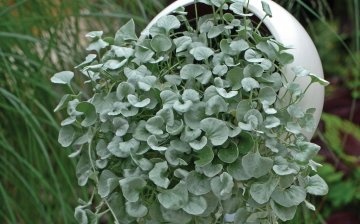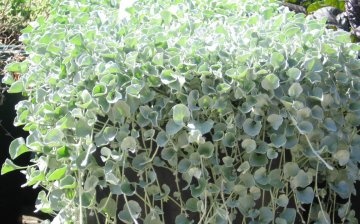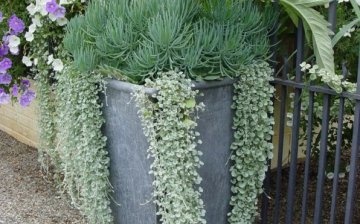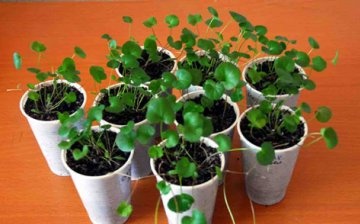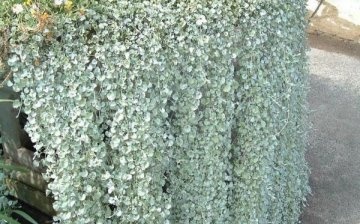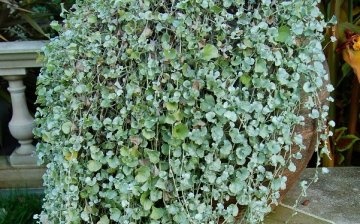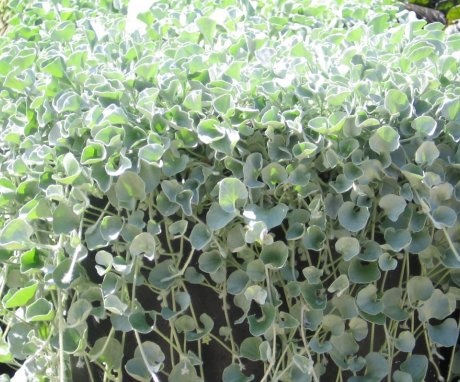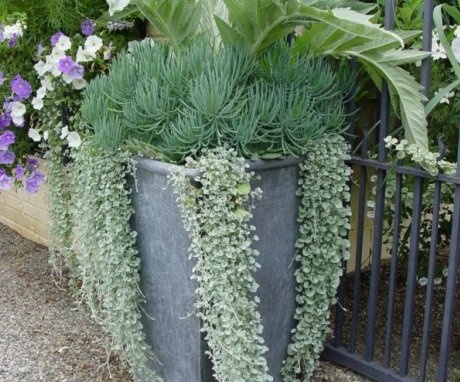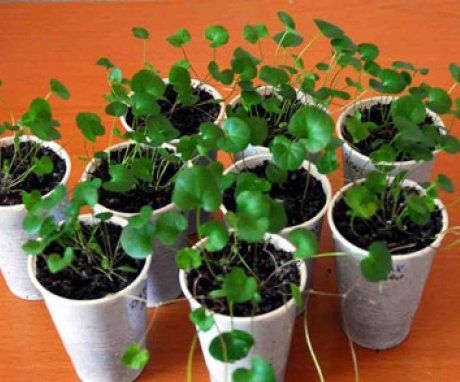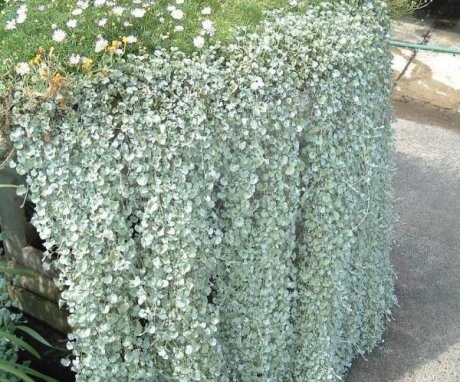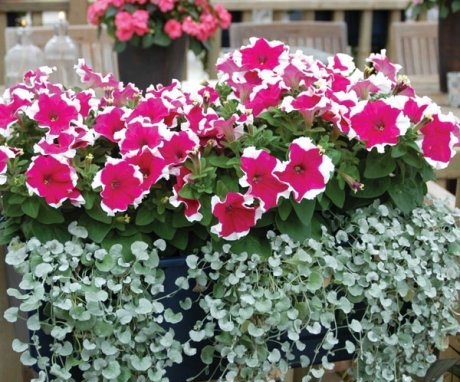Dichondra silvery - "silvery waterfall" in a pot
Silver dichondra (Dichondra argentea) is also called creeping dichondra (Dichondra repens). This plant from the genus of bindweed belongs to the ampelous perennial decorative deciduous vines. Dichondra is widely distributed in the Australian, American and East Asian countries. It is appreciated for the decorativeness of creeping branches, framed by thick leaves. It is widely used in landscape design for decorating gardens, loggias, gazebos and other buildings.
Content:
- Acquaintance with silver dichondra
- Description of plant varieties
- Seed propagation
- Propagation by cuttings
- How to care for a vine
- Where and how the plant is used
Acquaintance with silver dichondra
The name of the plant has Greek origins and is formed by two words: dic and chondros, which translates as two grains and characterizes the structure of the fruit.
Dichondra silvery is a perennial decorative deciduous creeping plant. Stems in nature can grow up to six to seven meters, and in domesticated species - up to two meters. Shoots can easily root at the nodes of the leaves. The lashes cascade and form a carpet, braiding the surface.
A feature of the silvery dichondra is that it grows more strongly in shaded areas.
Rounded small leaves (up to 2.5 cm) can be green, gray, silver, depending on the species. The plant blooms with small yellow-green flowers, which do not increase its decorative properties. Dichondra silvery can be grown indoors and used to decorate garden compositions.
Description of plant varieties
How many dichondra species is a moot point. According to some sources, there are about ten of them. But it is known for sure that the most common among florists and florists are two popular types:
- Dichondra "Silver Falls". This variety is distinguished by an unusual color of rounded pubescent leaves that resemble a waterfall of silver coins. The roots of the plant are superficial, and the height of the shoots does not exceed 20 cm, and their length reaches one and a half meters. The "Silver Waterfall" blooms with small nondescript purple flowers. This variety in garden compositions can favorably set off plants with bright flowers. Goes well with petunias, verbena, lobelia, balsam... Shoots of Silvery Falls Dichondra can create the illusion of running water when planted in the shape of a stream.
- Dichondra "Emerald Falls". The plant has long lashes and green leaves three millimeters in size. It blooms with small, rich yellow flowers that bloom throughout the summer season. In their homeland, dichondra is considered a weed. In some countries, the plant is used for lawn landscaping, which does not require a mowing. Landscape designers use the emerald waterfall of leaves to decorate sculptures, gazebos and fences. The "Emerald Falls" variety prefers light shading, but is capable of growing in sun-drenched meadows. If the plant is regularly sprayed, the density of the leaves will increase and the flower will look fresher.Dichondra "Emerald Falls" is easy to grow from seed, because it does not require special care.
Seed propagation
Sow seeds in mid-winter or early spring in seedling containers. Here, the main thing is when the dichondra will be needed for disembarkation. The plant gains full color 4 months after germination.
In order to grow a plant from seeds, you need to adhere to some rules:
- The soil should be composed of fertile soil and sand in equal proportions.
- Seed material must be buried in the ground no more than half a centimeter. Cover the top of the container with glass or transparent film. Placed in a warm place and moisturize periodically. When the first sprouts hatch, the shelter must be removed, but not immediately, but gradually. At the same time lowering the temperature of the content.
- If the temperature is maintained at 25 degrees, the sprouts will appear in 1.5-2 weeks.
- After the appearance of one or two pairs of leaves, the seedlings need to be planted from each other. A lot of space is needed for good growth of the lashes. The first individual container must be selected with a diameter of at least 10 cm.
- In the case of landscaping the garden, the seedlings are transplanted to a permanent place two months after picks.
If the plant is needed to decorate a room, balcony or loggia, then sprouts can be dived into pots and three seedlings at once. As it grows, the plant should be bent to the ground. So the shoots can take root with the roots in the internodes of the leaves. The result is a thick, silvery waterfall. To give the plant the correct shape, the shoots of dichondra should be cut off, and cut cuttings are suitable for rooting.
In winter, in the open ground, the plant dies, therefore, in order not to mess with the seeds, the dichondra can be brought into the heat: into the house or on a closed gazebo, and in the spring it can be pruned and planted in the garden.
Propagation by cuttings
It is much easier and faster to propagate the dichondra "Silver Falls" in this way, because the plant takes root well and grows rapidly.
To grow a new plant, it is enough:
- cut off the stems and place them in water so that they take root. This is usually done in autumn or spring time.
- a week later, when the first roots appear, the seedlings are planted in separate containers
- after 20-30 days, young plants are planted in a permanent place
Cuttings - an easier and more convenient way of propagation, however, many growers still prefer to sow seeds. First, cuttings of the Silver Falls dichondra can be difficult to obtain. Secondly, after planting the cuttings, the plant must be kept warm, which is not always convenient.
How to care for a vine
Dichondra "Silver Waterfall" is an unpretentious plant and does not require much effort to grow. It grows rapidly and has a strong immunity to diseases and harmful insects.
In order to get a beautiful and lush plant that will decorate a garden or balcony with silver, it is enough to regularly water it, spray it and guess the location. And in order to give the correct shape, the dichondra should be cut off annually.
Care features:
- Lighting. Dichondra "Silver Falls" prefers well-lit places. Due to the light, the plant reaches its maximum decorative effect. Also, the flower can grow in the shade, and the leaves will be smaller and dimmer.
- Temperature conditions. The optimum temperature for a plant is within 17-26 degrees. When the temperature drops to 11 degrees and below, it negatively affects the development of silvery dichondra.
- Humidity. "Silver Waterfall" does not require much moisture, but during periods of high temperatures and hot climates will be grateful for spraying... The foliage will become firmer and brighter.
- Irrigation. The only requirement that should be strictly followed so that the plant does not lose its decorative effect. Soil in the area root system must be constantly moisturized, so dichondra needs regular and abundant irrigation. But there should be no stagnation of water, otherwise the flower will wither.
- Fertilization. During the growing season, it is worth feeding dichondra fertilizers for decorative deciduous plants twice a month. In winter, feeding is stopped.
- Transfer... Often there is no need to transplant a flower. Transplanted as needed, when the roots are tightly entwined with an earthen lump. However, many growers grow dichondra as an annual, so in the fall they simply cut and root young shoots. So that young plants do not go into active growth, they are placed in a dark, cool room.
-
Susceptibility to disease and pests. Dichondra is distinguished by an amazing stable immunity to diseases and harmful insects. Although, cases of infection are recorded nematode... In case of defeat, the damaged lashes should be removed and destroyed. Then you need to carry out additional treatment with insecticides.
Where and how the plant is used
Dichondra "Silver Falls" looks favorably on the alpine slides. With proper planting and placement, the plant creates the illusion of a stream running through the stones. When sunlight hits the foliage, it lets out "bunnies" and, as if, sparkles. Also, the plant favorably emphasizes the colorfulness of bright colors.
When decorating walls and fences on the site, you should take care of the correct placement, and you should also not forget that the dichondra lashes take root well during the growth process.
Therefore, plants should not be allowed on walls made of clay or other materials that can be damaged by the influence of the roots. Landscape designers practice decorating balconies, loggias, verandas and gazebos using the Silver Falls. This approach allows you not only to create a beautiful look, but also to shade the room.
Spectacular and undemanding in care, the "Silver Waterfall" dichondra acts as an elegant decor. With a flowing silvery cascade, it forms a slight contrast against the background of rich greenery and colors in a blooming summer garden.
More information can be found in the video:



